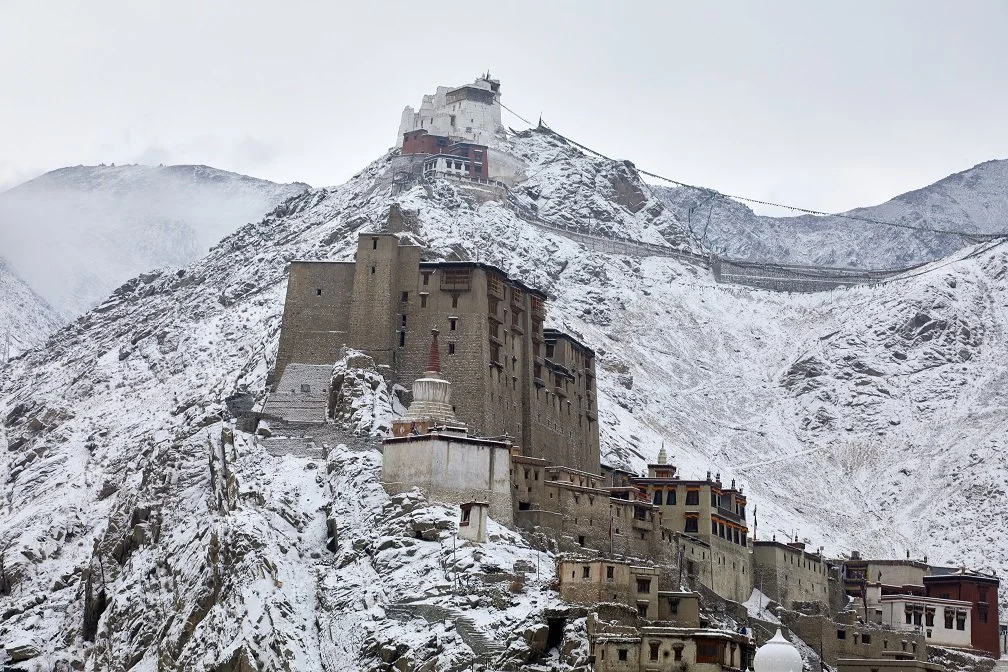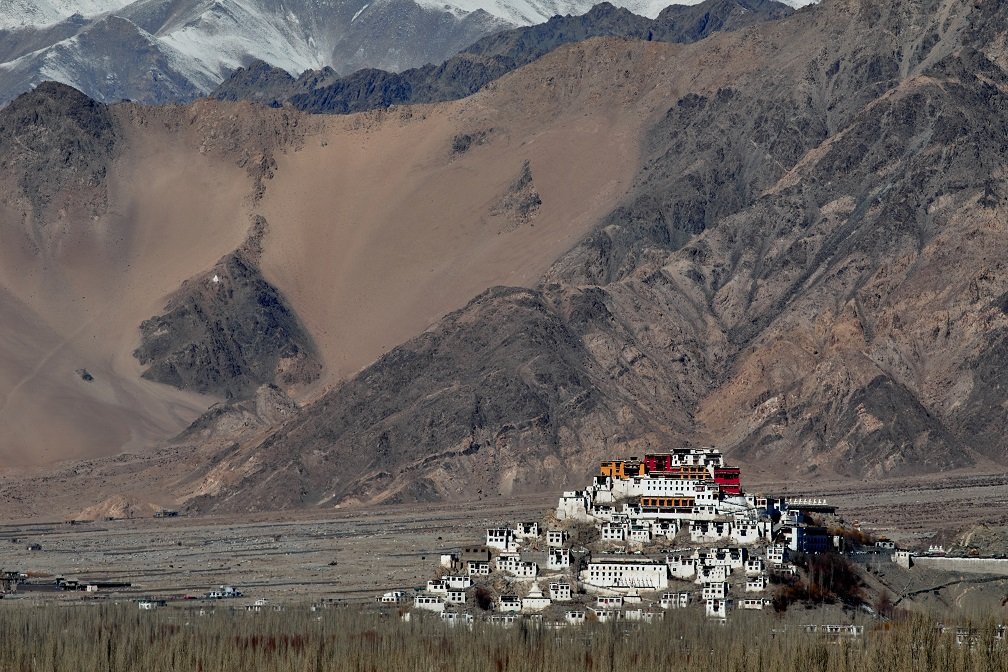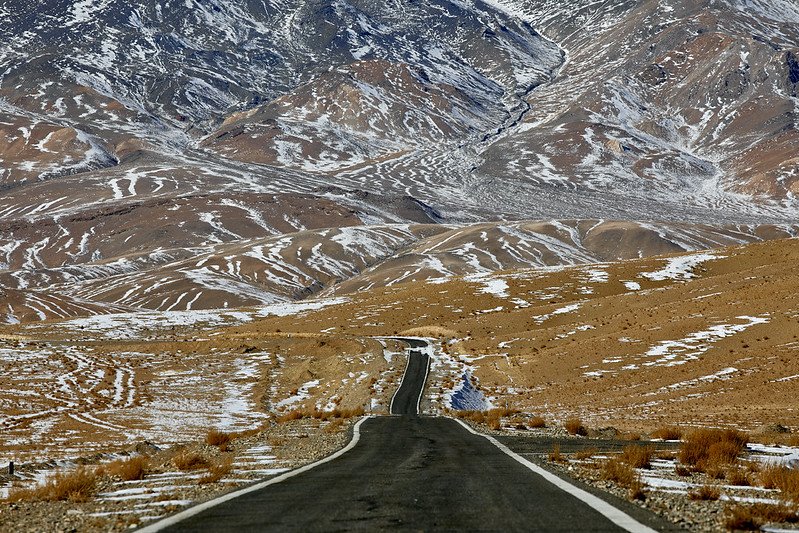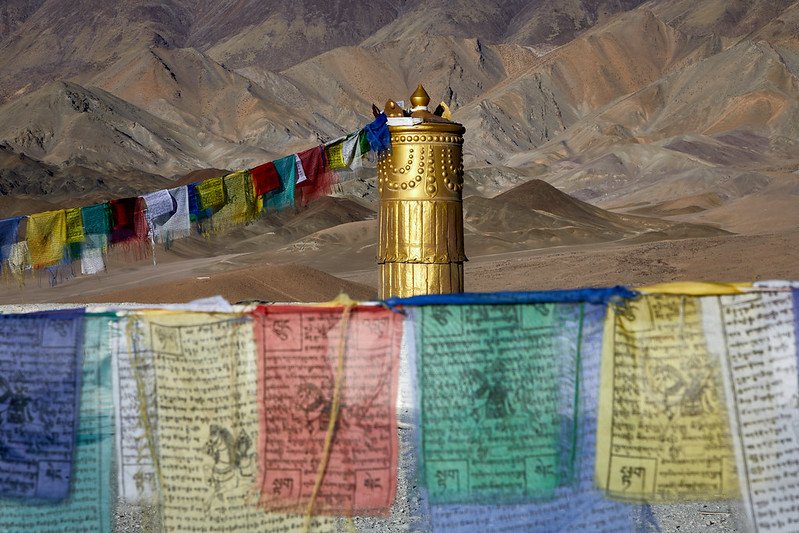Hidden Bhutan Itinerary
Day 1: Arrive in Paro
Most flights into Paro International Airport arrive in the morning. You will be met at the airport by your local guide and driver and taken to your hotel for lunch and a short rest.
In the afternoon we will visit the spectacular, riverside Paro Rinpung Dzong, which means the fortress on heap of a jewels. Built by Zhabdrung Ngawang Namgyel in 1646 it’s one of the most spectacular dzongs in the country and a brilliant opening to your Bhutan adventure. If you’re not too tired, then after the dzong we will head to the 17th Century Taa Dzong (watch tower) which now contains the superb national museum.
Day 2: Acclimatisation day and monasteries around Leh
This is another important acclimatisation day, which is spent visiting some of the incredible Buddhist monasteries in the countryside around Leh. Highlights include the 19th Century mud brick Stok Palace, which is still used by members of Ladakhs former Royal Family. The massive Thiksey Gompa, one of Ladakh’s biggest and most attractive monastery complexes known for ornate statue of the Future Buddha. And the secluded and delightful Hemis monastery tucked into a rocky side valley. We return to Leh for dinner.
Day 3: Acclimatisation day and visiting monasteries around Leh
This is the third and final acclimatisation day. Today is spent exploring the countryside west of Leh which is dotted with stunning Buddhist sites including the Phyang monastery set beneath a great shaft of mountain peaks. If you are not suffering from any signs of AMS and if weather conditions permit, then we can also make the spectacular road trip to the Khardung La mountain pass. At 5602m it’s known as one of the highest driveable mountain passes in the world and the view from the prayer flag covered top is simply out of this world.
Day 4: Snow leopard safari, Hemis National Park
After breakfast drive to the village of Rumbak deep in the Hemis National Park. The drive takes 2-3 hours from Leh and follows the course of the Zanskar River through superb mountain scenery. On arrival meet our host family and check into our homestay accommodation. In the afternoon we set out on foot to look for snow leopards in the side valleys leading away from Rumbak. We have a good record of seeing leopards here and a team of local spotters from Rumbak will fill us in on the current best locations to look for them. Other animals that might be seen include blue sheep (the favoured dinner of snow leopards), pica, wolf, Redfox, wooly hare, Eurasian lynx, Tibetan argali and Asiatic ibex. Rumbak is also a great birding valley with many unique Himalayan species present including Tibetan snowcock, Himalayan snowcock, wall creeper, fire-fronted serin, golden eagle, bearded vulture and others. Return to the homestay for a traditional Tibetan dinner.
Day 5: Snow leopard safari, Hemis National Park
We remain in the Rumbak area today but walk further up the valley to another good snow leopard spot. The walk (which is often through snow) is easy but takes about 3-4 hours return. You will walk through deserted mountain valleys to arrive at a small hamlet from where there are views over the valley to a slope favoured by blue sheep and those that eat blue sheep! Return to Rumbak for dinner.
Day 6: Snow leopard safari, Ullay.
Depending on how lucky we have been with snow leopard and other wildlife sightings over the past two days we will either spend a couple of hours early in the morning continuing our search for snow leopards around Rumbak or we will leave straight after breakfast for our next wildlife spotting destination of Ulley.
It takes around five hours to drive from Rumbak to Ulley, which is west of Leh. The journey is a non-stop spectacle of high snowy mountains, narrow gorges and rivers filled with blocks of ice. Ulley itself, an old Tibetan-style village of solid farmhouses surrounded by snow-capped peaks and set at the foot of a shaft of rock topped by a massive Buddhist monastery, is a stunning sight. Depending on our arrival time we will either head straight out in search of snow leopards or spend some time exploring the village and visiting the monastery. Our accommodation in Ulley is in a cozy, traditional Tibetan-style homestay.
Day 7: Snow leopard safari and return to Leh
Most of day seven is spent scouting the vast mountainscapes around Ulley for snow leopards. The landscape around Ulley is much more open, and the mountains much larger, than the Rumbak area and it might seem an impossible task to find a leopard here but our success rate is actually very high. We’ve even watched leopards hunting here! By mid-afternoon though we start our return to Leh (two hours) where we check in to our upmarket hotel and take advantage of hot showers and in-room heating!
Day 8: Journey to the Chuntang plateau
Today there’s a change of tempo to the tour as our focus moves away from leopards and wildlife to simply experiencing the sublime winter landscapes of Ladakh and getting to know the people who call the remotest corners of this state home. From Leh it’s a six-hour drive to our next destination, the small settlement of Hanle, which only opened to foreigners in the past couple of years. In the very far southeast of Ladakh, Hanle is situated on the wild Chungtang Plateau. A vast frozen desert, with an average elevation above 4000m, the Chungtang plateau is one of the coldest inhabited places on Earth with temperatures regularly falling to forty degrees below zero in winter. The landscapes on the Chungtang are nothing short of breathtaking. Unlike the enclosed mountain valleys we experienced on our first week in Ladakh, here the vistas stretch forever and the horizon seems to crush the land. Hanle itself is known for its large, hilltop 17th Century monastery which looks like a miniature version of Tibet’s Potala Palace and for the astronomical centre with its powerful telescopes that peer deep into the gloom of the galaxy. But first, we must get there. The drive to Hanle takes us down a tight, snaking gorge alongside the mighty Indus River. With every kilometre passed the scenery gets more and more dramatic. At one point we will stop to examine some ancient petroglyphs scattered along the banks of the Indus and there are plenty of opportunities to stop for photos and explore little villages. Our accommodation is on a small Tibetan-style homestay.
Day 9: The Frozen Serengeti
Today we explore the area around Hanle. Our plans are actually a little flexible depending somewhat upon the specific interests of your group and the weather and snow conditions (snow is actually rare on the Changtung plateau). We generally start the day with a half-day driving safari into the domed hills high above Hanle where we cross 5000m plus mountain passes, explore dry valleys that don’t seem to be of this world at all and stop at the camps of Changpa nomads to drink Tibetan salted tea and learn something of the lifestyle of these tough people. After lunch we explore the huge monastery complex and pay a visit to the astronomy centre. Alongside the landscapes, people and culture of this area another, perhaps unexpected, highlight is the highly visible wildlife we will likely see. The Chungtang plateau is sometimes known as a ‘frozen Serengeti’. As you’ll quickly realise, this is an appropriate description because despite the harsh and arid terrain, wildlife is abundant and as we explore the plateau we always keep our eyes peeled for wolves (there are several very visible packs here), herds of Tibetan ass and Tibetan antelope (chiru) and maybe even the elusive Pallas cat.
Day 10: Tso Moriri Lake
Today we leave Hanle and take you on a journey through the sort of Tibetan landscapes you always dreamt of! The goal of the day is to reach the sublime – and at this time of year – normally frozen, Tso Moriri lake. The exact route we take to get here does depend a lot on snow conditions on the day. If possible, we take a highly remote road travelled by very few foreign visitors. The road takes us over 5000m plus mountain passes and through valleys ruled by nomads and their flocks to arrive at the southern end of Tso Moriri. At an altitude a little over 4500m, this saline lake attracts numerous birds, as well as nomads and their livestock in summer, but in winter the landscape is silent and largely uninhabited. But what a sight this lake is! We will take time to explore around the lake shore and admire the strange ice patterns that form on the lake surface and listen to the grinding and crunching noise of the ice sheets crashing into one and other. We then head down to a small roadside village with natural hot springs where we spend the night in a very simple guesthouse.
Day 11: Frozen Lakes and nomads
Today we again set off early for the two-hour drive along an Alpine valley to the twin lakes of Tso Kar and Startsapuk Tso. The landscape around these lakes is a little more fertile than around Tso Moriri and people live here year-round. There are a couple of small villages close to the lakes and many nomads spend the winter here. We will visit some of the nomad camps and see them out with their livestock. We will also keep a sharp eye out for the wolves, wild ass and antelope commonly seen around here. The lakes themselves are the real attraction though. Startsapuk Tso is a freshwater lake while Tso Kar is saline. Walking out onto the frozen salt crust of Tso Kar is an unforgettable experience. We overnight in a very simple guesthouse.
Day 12: Return to Leh
Today we travel slowly back to Leh. It’s a four-hour drive and so we have plenty of time to stop and explore villages and monasteries a short way off the main road. Depending on our arrival time back in Leh there might be the opportunity to visit some more sights in and around Leh including the Shanti Stupa or the palace. Accommodation will be in a luxury hotel.
Day 13: Fly back to Delhi
Most flights from Leh back to Delhi leave early in the morning. We will drop you off at the airport in good time for your flight. The tour ends at Leh airport.
We also offer extensions to this journey to other parts of Ladakh and elsewhere in India.












